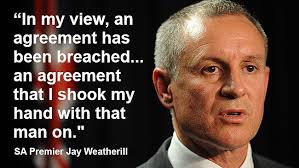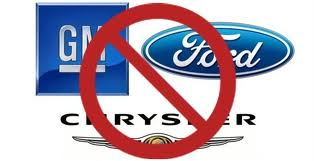 Holden is a major manufacturing icon of Elizabeth and South Australia. Now there is the threat of it disappearing from Australia, like Ford announced just a couple of months ago. General Motors (GM) state that their Australian subsidiary here is not profitable and competitive enough and so they seek extra government financial subsidies and more sacrifices from workers. It is all a one way street, which leads back to GM’s headquarters in the United States.
Holden is a major manufacturing icon of Elizabeth and South Australia. Now there is the threat of it disappearing from Australia, like Ford announced just a couple of months ago. General Motors (GM) state that their Australian subsidiary here is not profitable and competitive enough and so they seek extra government financial subsidies and more sacrifices from workers. It is all a one way street, which leads back to GM’s headquarters in the United States.
All the mass media, government and big business commentators on the issue of what to do about the ‘General’ fall into two camps: either ‘free market’ fundamentalists who want all manufacturing industry based in the lowest-wage countries; or ‘Keynesian’ (Keynes was an economist who promoted government financial investment in infrastructure and industry to kick start economic activity) subsidisers who want to continue bribing GMH and other manufacturers to keep ‘making things’ in Australia just a little longer. But they have a lot more in common than their ‘disagreement’ makes it seem.
Media and Governments – Pandering to corporate profit-making.
Either let GMH and others ‘relocate’ to wherever they can find the lowest-possible wages, or throw more hundreds of millions of dollars at them to stay (for the moment).
The second ‘choice’ means that multinationals like GMH continue to escalate their demands to state and federal governments and workers.
This tax-payer subsidised dinosaur has blackmailed successive state and federal governments to get one financial rescue package after another, with the threat of closing its Australian operations – as other multinationals like Mitsubishi did before them. And finally, inevitably, Mitsubishi didn’t get enough – and abandoned South Australia anyway. Who’s betting GMH will do any different?
Corporate Blackmail
 Meanwhile, after having been promised $275 million dollars by the SA, Victorian and Federal governments, they have demanded a doubling of government investment in building its next generation Holden Commodore and Holden Cruze here, otherwise it will close its local manufacturing operations in 2016. That’s another quarter of a billion dollars ransom. It has also attacked its workforce on previous occasions, cutting out shifts and reducing workers to a four day week. It is currently finalising 400 job cuts at Elizabeth and 100 at its Port Melbourne engineering plant.
Meanwhile, after having been promised $275 million dollars by the SA, Victorian and Federal governments, they have demanded a doubling of government investment in building its next generation Holden Commodore and Holden Cruze here, otherwise it will close its local manufacturing operations in 2016. That’s another quarter of a billion dollars ransom. It has also attacked its workforce on previous occasions, cutting out shifts and reducing workers to a four day week. It is currently finalising 400 job cuts at Elizabeth and 100 at its Port Melbourne engineering plant.
Next it demanded a direct wage cut of up to $200 per week, the workers quite rightly said no! Now the ‘General’ is trying on the new tactic of take it or we’ll leave you extortion: a loss of a 3% pay rise for each of the next 3 years (a pay cut), “smoko’ breaks cut backed, diminished sick days and holiday entitlements, and the imposition of unscheduled shifts.
What that amounts to is, move your wages and conditions downwards towards those of the lower-wage countries, or we move there anyway – the first ‘choice’. It is simply outrageous that one of the biggest corporations in the world can make demands of this nature. It is clearly past its use-by-date as a global entity as its US government rescue packages and its closure of plants such as the GM Opel plant in Bochum, Germany with 3000 job losses, announced in April, show; it is in crisis, a crisis of over-production and a crisis of capital investment and production costs. It treats its workers as one more just-in-time production component, laying off and hiring workers according to the anarchic whims of the market.
The Alternative – Nationalise and Plan for Australia’s Future Needs
The alternative answer to the problems besetting the manufacture of vehicles in Australia is to nationalise without compensation the entire industry and rationalise and plan its production to the needs of Australians.
If General Motors pulls the pin, plant and equipment should stay here. It needs to be remembered that The Chifley ALP Government in the 1940s gave General Motors Holden £2.5 million Australian pounds to fund the first Holden car. General Motors parent corporation did not put in a penny, according to Laurence Harnett (a Holden’s managing director in the 1940s) in his book Big Wheels Little Wheels.
Workers have more than paid for the cost to General Motors of plant and equipment through the millions of dollars profits from Australian workers shipped back to the USA since General Motors-Holden Ltd was formed in 1931!
What do urban Australians need in the way of a small, green energy car?
Build it to meet that need.
What do Australian primary producers and urban tradespeople need in the way of a utility vehicle?
Build it to meet that need.
What vehicles are required for better public transport? Design and build trains, trams and buses.
What can be done with these big manufacturing facilities in the way of research and development for advanced manufacturing capacity?
Provide the funds and unleash the creativity of the workers both manual and intellectual.
What can be done for the workers?
Give them the responsibility to control the process and intensity of production, and to determine the social purposes to which their surplus value (profit) is put instead of seeing it disappear overseas.
 Economic and political independence for Australia
Economic and political independence for Australia
Of course, to follow this alternative Australia needs to take decisive steps towards economic and political independence from the US, and from multinationals from wherever. Only when we move in that direction can Kevin Rudd’s desire for Australia to be a country that “makes things” be more than empty ‘polly-speak’.




